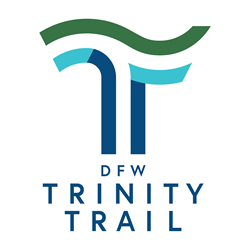Participants can have their voices heard by voting and sharing their opinions on the names and associated branding at
www.FortWorthToDallasTrail.com. An interactive map also allows input on participants’ favorite trail destinations that could be included on wayfinding signage. The 60-mile-plus trail will connect downtown Fort Worth, Arlington, Grand Prairie, Irving, and downtown Dallas. These five cities have partnered with the North Central Texas Council of Governments to fund, design, and construct various trail segments for almost a decade. The final 3 segments are anticipated to be complete by the end of 2023 or early 2024.
The logo accompanying each name celebrates the name’s features. The DFW Trinity Trail logo includes green and blue graphics representing the flow of the Trinity River. The DFW Discovery Trail logo features different animals that might be discovered throughout the corridor. The colors and animals shown on this logo can be customized to reflect the unique nature of individual trail segments. The new name will be cobranded with existing individual trail segment names to preserve their unique nature.
Most of the trail consists of 15-foot-wide concrete multiuse paths, ideal for many types of long-distance races and community events. One of the first in the region to connect multiple cities, the trail is being designed to put the metroplex on the map as an area that can host large, nationally-competitive sports and other events.
The trail is composed of off-street segments through parks, green fields, neighborhoods, regional entertainment complexes, and business parks along the Trinity River. Trail users encounter some of the most pristine nature to be found in the heart of the Dallas-Fort Worth area.
In addition to serving nearby communities and hosting regional and national events, the trail is anticipated to be used as transportation for pedestrians and cyclists, with connections at two Trinity Railway Express (TRE) train stations and hundreds of employers along the corridor.
Improved air quality is another potential benefit of this regional corridor, as 10 North Texas countries are currently in nonattainment for ozone and are working to meet the federal standard. Transportation alternatives such as this trail are among the many NCTCOG-driven regional initiatives intended to address air quality issues.
For more information about the Fort Worth to Dallas Regional Trail and the branding project, visit
www.nctcog.org/FWtoDalTrail.

 About the North Central Texas Council of Governments:
About the North Central Texas Council of Governments:
NCTCOG is a voluntary association of local governments established in 1966 to assist local governments in planning for common needs, cooperating for mutual benefit and coordinating for sound regional development. NCTCOG's purpose is to strengthen both the individual and collective power of local governments and to help them recognize regional opportunities, eliminate unnecessary duplication and make joint decisions.
NCTCOG's purpose is to strengthen both the individual and collective power of local governments and to help them recognize regional opportunities, eliminate unnecessary duplication, and make joint decisions. NCTCOG serves a 16-county region of North Central Texas, which is centered on the two urban centers of Dallas and Fort Worth. Currently, NCTCOG has 229 member governments including 16 counties, 169 cities, 19 school districts and 27 special districts.